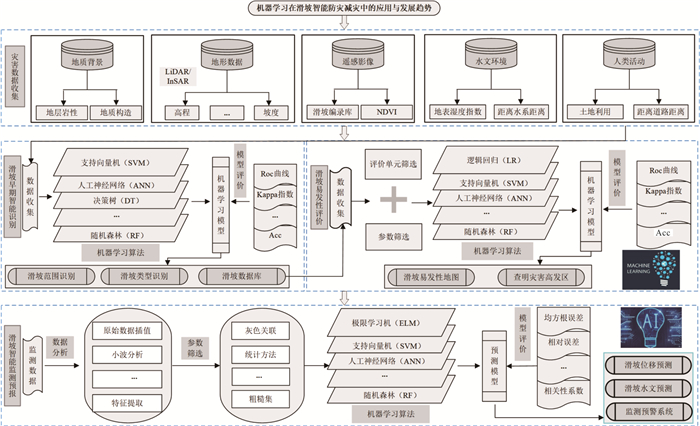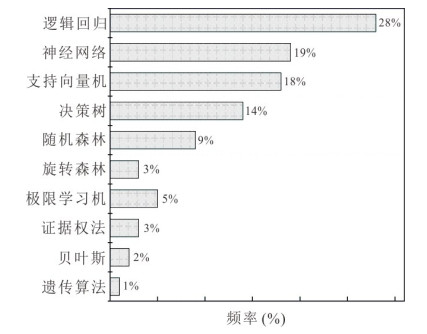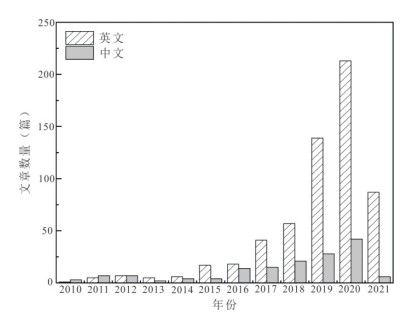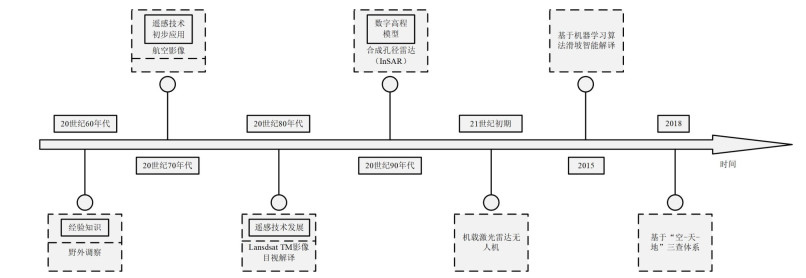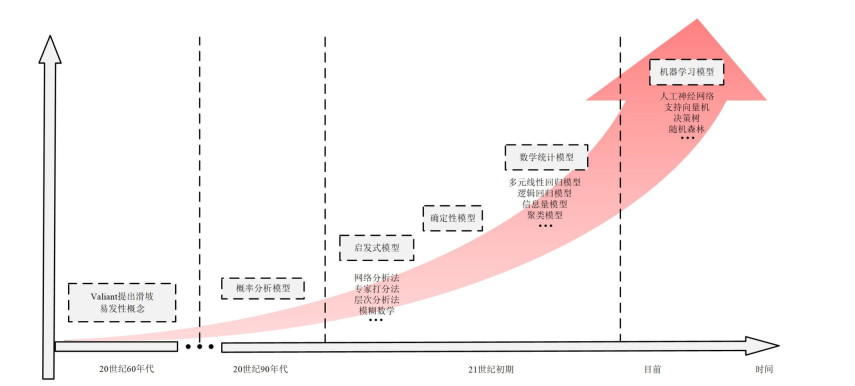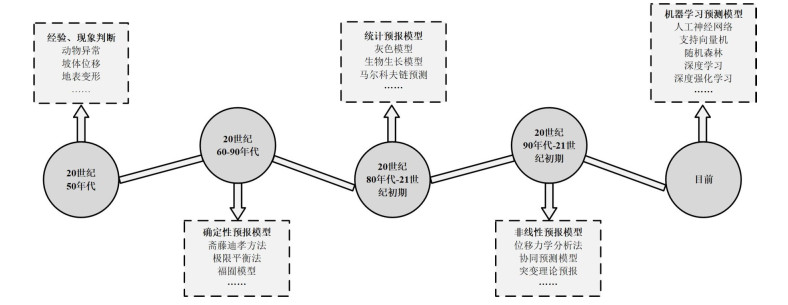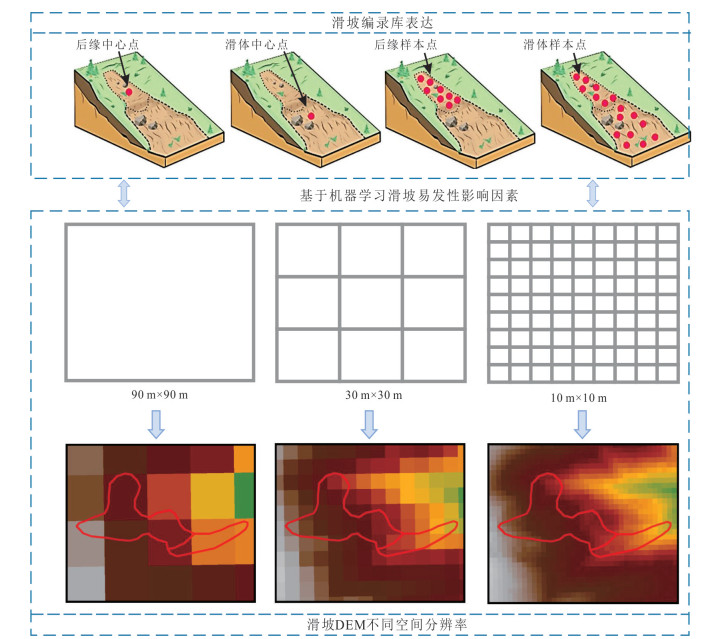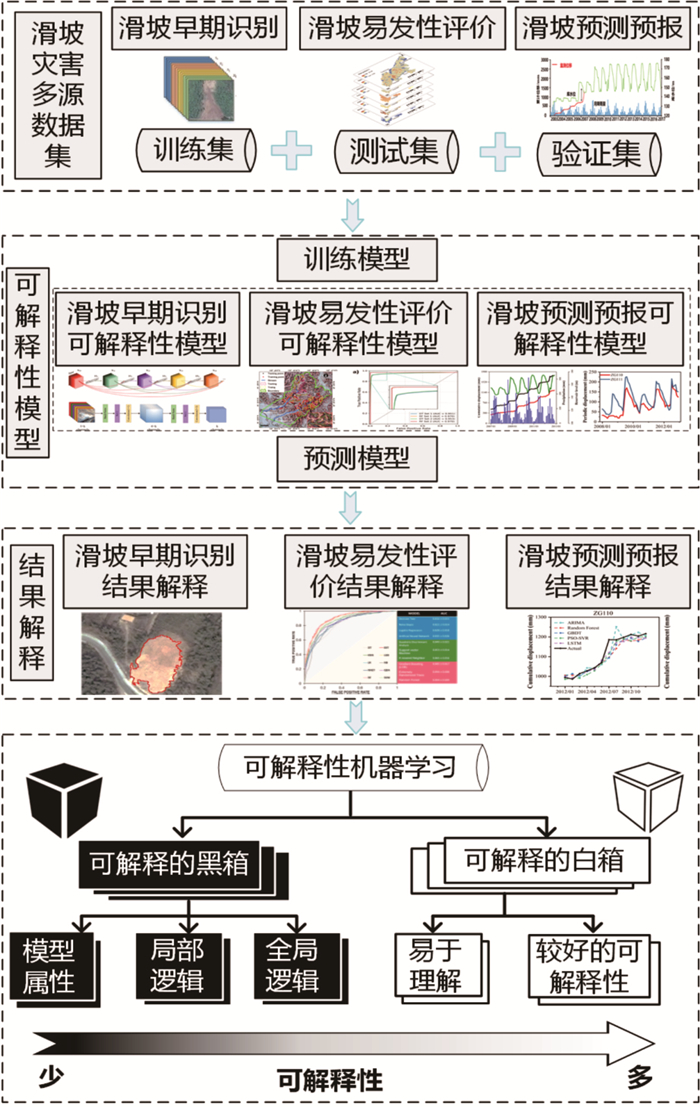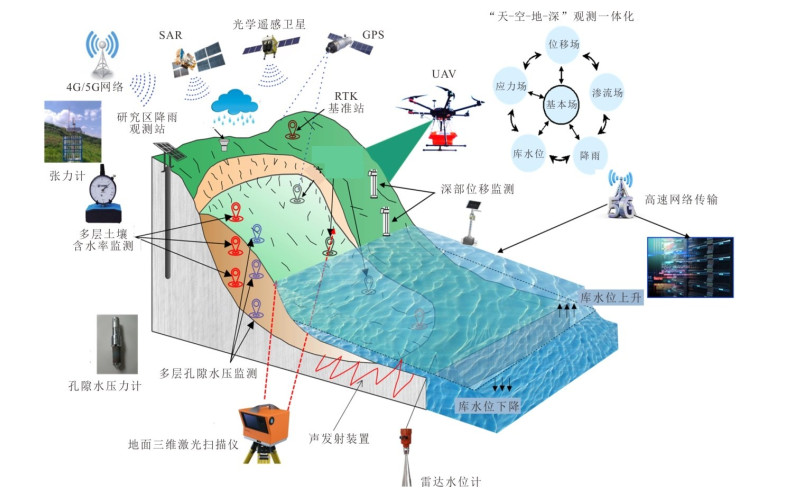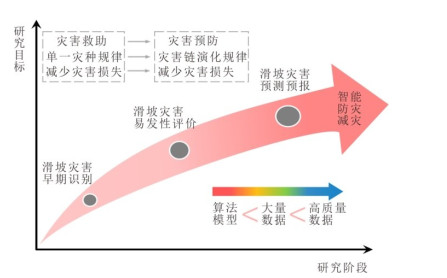Application and Development Trend of Machine Learning in Landslide Intelligent Disaster Prevention and Mitigation
-
摘要:
滑坡灾害易发频发、点多面广、隐蔽性强、危害严重.开展“天‒空‒地‒深”观测一体化的滑坡早期识别、易发性评价及预测预报,对于保障人民生命和财产安全,推进滑坡灾害防治能力现代化具有重要意义.目前,依靠人工解译的滑坡识别耗时耗力,采用启发式模型的滑坡易发性评价不能较好地探明环境因子之间的非线性关系,基于传统监测数据的滑坡预测预报精度较低.机器学习算法凭借其强大的非线性处理能力及鲁棒性等优势,逐渐广泛应用于滑坡智能防灾减灾中.基于此,本研究系统阐述了机器学习在滑坡灾害早期识别、易发性评价及预测预报等方面的具体应用,综述了多种机器学习算法在上述3个领域中运用的优劣,最终对机器学习在滑坡灾害中未来的发展趋势进行了展望.
Abstract:Landslide is prone to occur frequently with many aspects, wide coverage, and serious threats. Therefore, based on "satellite-aerial-surface-deep" collaborative integrated big data observations, it is of great significance to carry out early landslide identification, susceptibility assessment, and prediction to ensure the safety of people's lives and property, and to promote the modernization of landslide disaster prevention capability. At present, the landslide early identification relying on manual interpretation is time-consuming and labor-intensive, the landslide susceptibility assessment using a heuristic model cannot better prove the nonlinear relationship between environmental factors, and the landslide prediction accuracy based on single monitoring data is low. The machine learning algorithm is gradually widely used in landslide disaster prevention and mitigation because of its strong nonlinear processing ability and robustness. Based on this, the study systematically expounds on the specific application of machine learning in early identification, susceptibility assessment, and prediction of landslide disasters, summarizes the advantages and disadvantages of various machine learning algorithms in the above three fields, and finally prospects the future development trend of machine learning in landslide disasters.
-
图 9 基于机器学习滑坡易发性影响因素:滑坡编录库表达与地形高程不同空间分辨率(据Chang et al., 2019;Dou et al., 2020b修改)
Fig. 9. Influencing factors of landslide susceptibility based on machine learning: landslide inventory database representation and terrain DEM with different spatial resolutions (modified by Chang et al., 2019; Dou et al., 2020b)
表 1 常用机器学习算法的对比
Table 1. Comparison of common machine learning algorithms
常用机器
学习算法主要原理 优点 缺点 逻辑回归 基于现有数据对分类边界线建立回归公式,以此进行分类 ①计算代价不高
②易于理解和实现①容易欠拟合
②分类精度可能不高决策树 基于数据属性采用树状结构建立决策模型 ①复杂度不高
②对中间值的缺失不敏感
③可以处理不相关特征数据可能会产生过度匹配问题 人工神经网络 模拟生物神经网络,是一类模式匹配算法,是机器学习的一个庞大分支,有几百种不同的算法 ①类准确度高
②学习能力强①需要大量的参数
②不能观察学习过程,结果难以解释
③学习时间长支持
向量机寻找最佳超平面,可以将数据分成两部分,每部分数据都属于同一个类别 ①泛化错误率低
②计算开销不大
③结果易解释①对参数调节和核函数的选择敏感
②原始分类器不加修改适用于处理二类问题随机森林 用随机的方式建立一个森林,森林由很多独立决策树组成,最后综合得到最优分类结果 ①可充分应用有限样本
②具备多样性和准确性的优势在某些噪音较大的问题上会过拟合 深度学习 通过组合低层特征形成更加抽象的高层表示属性类别或特征,以发现数据的分布式特征表示 ①适应性强
②学习能力强、覆盖范围广
③可移植性好①训练耗时,模型验证复杂且麻烦
②便携性差,硬件成本较高 -
Ayalew, L., Yamagishi, H., Marui, H., et al., 2005. Landslides in Sado Island of Japan: Part I. Case Studies, Monitoring Techniques and Environmental Considerations. Engineering Geology, 81(4): 419-431. https://doi.org/10.1016/j.enggeo.2005.08.005 Bai, S. B., Wang, J., Lu, G. N., et al., 2008. GIS-Based Landslide Susceptibility Mapping with Comparisons of Results from Machine Learning Methods Process versus Logistic Regression in Bailongjiang River Basin, China. EGU, Vienna. Bai, X., Zhang, X. N., 2018. Application of Artificial Intelligence in Remote Sensing of Disaster Reduction. City and Disaster Reduction, (6): 82-87 (in Chinese with English abstract). Brabb, E. E., 1985. Innovative Approaches to Landslide Hazard and Risk Mapping. International Landslide Symposium Proceedings, Toronto. Cao, Y., Yin, K. L., Alexander, D. E., et al., 2016. Using an Extreme Learning Machine to Predict the Displacement of Step-Like Landslides in Relation to Controlling Factors. Landslides, 13(4): 725-736. https://doi.org/10.1007/s10346-015-0596-z Chang, K. T., Merghadi, A., Yunus, A. P., et al., 2019. Evaluating Scale Effects of Topographic Variables in Landslide Susceptibility Models Using GIS-Based Machine Learning Techniques. Scientific Reports, 9(1): 12296. https://doi.org/10.1038/s41598-019-48773-2 Chen, M. D., Wang, L. S., 1988. Grey Prediction Method of Slope Deformation and Failure. National Engineering Geology Conference, Chengdu (in Chinese). http://www.researchgate.net/publication/293232908_A_prediction_method_by_grey_system_for_slope_deformation_and_failure Chen, W., Pourghasemi, H. R., Kornejady, A., et al., 2017. Landslide Spatial Modeling: Introducing New Ensembles of ANN, MaxEnt, and SVM Machine Learning Techniques. Geoderma, 305: 314-327. https://doi.org/10.1016/j.geoderma.2017.06.020 Criss, R. E., Yao, W. M., Li, C. D., et al., 2020. A Predictive, Two-Parameter Model for the Movement of Reservoir Landslides. Journal of Earth Science, 31(6): 1051. doi: 10.1007/s12583-020-1331-9 Dou, J., Chang, K. T., Chen, S. S., et al., 2015. Automatic Case-Based Reasoning Approach for Landslide Detection: Integration of Object-Oriented Image Analysis and a Genetic Algorithm. Remote Sensing, 7(4): 4318-4342. https://doi.org/10.3390/rs70404318 Dou, J., Qian, J. P., Chen, S. S., et al., 2010. Object-Based and Case-Based Reasoning Method for Ground Collapses Detection. Journal of Image and Graphics, 15(6): 900-909 (in Chinese with English abstract). http://www.researchgate.net/publication/259813154_Object-based_and_case-based_reasoning_method_for_ground_collapses_detection Dou, J., Yunus, A. P., Bui, D. T., et al., 2020a. Improved Landslide Assessment Using Support Vector Machine with Bagging, Boosting, and Stacking Ensemble Machine Learning Framework in a Mountainous Watershed, Japan. Landslides, 17(3): 641-658. https://doi.org/10.1007/s10346-019-01286-5 Dou, J., Yunus, A. P., Merghadi, A., et al., 2020b. Different Sampling Strategies for Predicting Landslide Susceptibilities are Deemed Less Consequential with Deep Learning. Science of the Total Environment, 720: 137320. https://doi.org/10.1016/j.scitotenv.2020.137320 Dou, J., Yunus, A. P., Tien Bui, D., et al., 2019. Assessment of Advanced Random Forest and Decision Tree Algorithms for Modeling Rainfall-Induced Landslide Susceptibility in the Izu-Oshima Volcanic Island, Japan. Science of the Total Environment, 662: 332-346. https://doi.org/10.1016/j.scitotenv.2019.01.221 Du, L., Chen, J., Li, M. M., et al., 2019. The Application of Airborne LiDAR Technology to Landslide Survey: A Case Study of Zhangjiawan Village Landslides in Three Gorges Reservoir Area. Remote Sensing for Land & Resources, 31(1): 180-186 (in Chinese with English abstract). http://en.cnki.com.cn/Article_en/CJFDTotal-GTYG201901025.htm Fell, R., Ho, K., Lacasse, S., et al., 2005. State of the Art Paper 1-A Framework for Landslide Risk Assessment and Management. Proceedings of the International Conference on Landslide Risk Management. Vancouver. Feng, X. T., Ma, P. B., 2001. Identifying Stability of Underground Openings Based on Data Mining. Chinese Journal of Rock Mechanics and Engineering, 20(3): 306-309 (in Chinese with English abstract). http://www.researchgate.net/publication/293700794_Identifying_stability_of_underground_openings_based_on_data_mining Ge, D. Q., Dai, K. R., Guo, Z. C., et al., 2019. Early Identification of Serious Geological Hazards with Integrated Remote Sensing Technologies: Thoughts and Recommendations. Geomatics and Information Science of Wuhan University, 44(7): 949-956 (in Chinese with English abstract). http://en.cnki.com.cn/Article_en/CJFDTotal-WHCH201907001.htm Guo, C., Xu, Q., Dong, X. J., et al., 2021. Geohazard Recognition by Airborne LiDAR Technology in Complex Mountain Areas. Geomatics and Information Science of Wuhan University, 46(10): 1538-1547 (in Chinese with English abstract). http://d.wanfangdata.com.cn/periodical/dqkx-e202105004 Guo, Y. H., Dou, J., Xiang, Z. L., et al., 2023. Optimized Negative Sampling Strategy of Gradient Boosting Decision Tree and Random Forest for Evaluating Wenchuan Coseismic Landslides Susceptibility Mapping. Bulletin of Geological Science and Technology (in Chinese with English abstract). Guo, Z. Z., Shi, Y., Huang, F. M., et al., 2021. Landslide Susceptibility Zonation Method Based on C5.0 Decision Tree and K-Means Cluster Algorithms to Improve the Efficiency of Risk Management. Geoscience Frontiers, 12(6): 101249. https://doi.org/10.1016/j.gsf.2021.101249 Guzzetti, F., Galli, M., Reichenbach, P., et al., 2006. Landslide Hazard Assessment in the Collazzone Area, Umbria, Central Italy. Natural Hazards and Earth System Sciences, 6(1): 115-131. https://doi.org/10.5194/nhess-6-115-2006 Guzzetti, F., Mondini, A. C., Cardinali, M., et al., 2012. Landslide Inventory Maps: New Tools for an Old Problem. Earth-Science Reviews, 112(1-2): 42-66. https://doi.org/10.1016/j.earscirev.2012.02.001 Han, J. N., Sun, Z. H., 2018. Application of Satellite Remote Sensing in Landslide Recognition. Resource Conservation and Environmental Protection, (11): 117 (in Chinese with English abstract). Hong, H. Y., Miao, Y. M., Liu, J. Z., et al., 2019. Exploring the Effects of the Design and Quantity of Absence Data on the Performance of Random Forest-Based Landslide Susceptibility Mapping. CATENA, 176: 45-64. https://doi.org/10.1016/j.catena.2018.12.035 Horvitz, E., Mulligan, D., 2015. Data, Privacy, and the Greater Good. Science, 349(6245): 253-255. https://doi.org/10.1126/science.aac4520 Hu, X. D., Huang, C., Mei, H. B., et al., 2021. Landslide Susceptibility Mapping Using an Ensemble Model of Bagging Scheme and Random Subspace-Based Naïve Bayes Tree in Zigui County of the Three Gorges Reservoir Area, China. Bulletin of Engineering Geology and the Environment, 80(7): 5315-5329. https://doi.org/10.1007/s10064-021-02275-6 Huang, F. M., Chen, J. W., Tang, Z. P., et al., 2021. Uncertainties of Landslide Susceptibility Prediction Due to Different Spatial Resolutions and Different Proportions of Training and Testing Datasets. Chinese Journal of Rock Mechanics and Engineering, 40(6): 1155-1169 (in Chinese with English abstract). Huang, F. M., Ye, Z., Yao, C., et al., 2020. Uncertainties of Landslide Susceptibility Prediction: Different Attribute Interval Divisions of Environmental Factors and Different Data-Based Models. Earth Science, 45(12): 4535-4549 (in Chinese with English abstract). Ji, S. L., Li, J. F., Du, T. Y., et al., 2019. Survey on Techniques, Applications and Security of Machine Learning Interpretability. Journal of Computer Research and Development, 56(10): 2071-2096 (in Chinese with English abstract). http://en.cnki.com.cn/Article_en/CJFDTotal-JFYZ201910004.htm Ji, S. P., Yu, D. W., Shen, C. Y., et al., 2020. Landslide Detection from an Open Satellite Imagery and Digital Elevation Model Dataset Using Attention Boosted Convolutional Neural Networks. Landslides, 17(6): 1337-1352. https://doi.org/10.1007/s10346-020-01353-2 Ju, Y. Z., Xu, Q., Jin, S. C., et al., 2020. Automatic Object Detection of Loess Landslide Based on Deep Learning. Geomatics and Information Science of Wuhan University, 45(11): 1747-1755 (in Chinese with English abstract). http://www.researchgate.net/publication/346647039_shiyongshenduxuexifangfashixianhuangtuhuapozidongshibieAutomatic_Object_Detection_of_Loess_Landslide_Based_on_Deep_Learning Kalman, R. E., Bucy, R. S., 1961. New Results in Linear Filtering and Prediction Theory. Journal of Basic Engineering, 83(3): 95-108. https://doi.org/10.1115/1.3658902 Kirschbaum, D., Stanley, T., Zhou, Y., 2015. Spatial and Temporal Analysis of a Global Landslide Catalog. Geomorphology, 249: 4-15. https://doi.org/10.1016/j.geomorph.2015.03.016 Lantz, B., 2015. Machine Learning with R. Packt Publishing, Birmingham. Li, X. P., Tang, H. M., Zhou, S. P., 2005. Logistic Regression Analysis on Sensitivity of Regional Landslide Factors. Journal of Earth Science and Enivronmental, 27(4): 14-18 (in Chinese with English abstract). http://en.cnki.com.cn/Article_en/ http://search.cnki.net/down/default.aspx?filename=XAGX200504003&dbcode=CJFD&year=2005&dflag=pdfdown Li, X. Z., Xu, Q., 2003. Models and Criteria of Landslide Prediction. Journal of Catastrophology, 18(4): 71-78 (in Chinese with English abstract). http://en.cnki.com.cn/Article_en/CJFDTOTAL-ZHXU200304014.htm Li, Z. H., Zhang, C. L., Chen, B., et al., 2022. A Technical Framework of Landslide Prevention Based on Multi-Source Remote Sensing and Its Engineering Application. Earth Science, 47(6): 1901-1916 (in Chinese with English abstract). Lin, D. C., An, F. P., Guo, Z. L., et al., 2011. Prediction of Landslide Displacements through Multimode Support Vector Machine Model. Rock and Soil Mechanics, 32(S1): 451-458 (in Chinese with English abstract). http://en.cnki.com.cn/Article_en/CJFDTOTAL-YTLX2011S1082.htm Lin, L. S., Feng, X. T., Bai, S. W., et al., 2002. Application of Artificial Neural Network to Prediction of Sliding Slope. Rock and Soil Mechanics, 23(4): 508-510 (in Chinese with English abstract). http://en.cnki.com.cn/Article_en/CJFDTOTAL-YTLX200204026.htm Liu, H. L., Ma, Y. B., Zhang, W. G., 2021. Application of Big Data Techniques in Geological Disaster Analysis and Prevention: A Systematic Review. Journal of Disaster Prevention and Mitigation Engineering, 41(4): 710-722 (in Chinese with English abstract). Long, Y. J., Li, W. L., Huang, R. Q., et al., 2020. Automatic Extraction and Evolution Trend Analysis of Landslides in Mianyuan River Basin in the 10 Years after Wenchuan Earthquake. Geomatics and Information Science of Wuhan University, 45(11): 1792-1800 (in Chinese with English abstract). Luo, W., Dou, J., Fu, Y., et al., 2022. A Novel Hybrid LMD–ETS–TCN Approach for Predicting Landslide Displacement Based on GPS Time Series Analysis. Remote Sensing, 15: 229. https://doi.org/10.3390/rs15010229 Lü, X. L., Song, J., 2019. Big Data Mining and Statistical Machine Learning. China Renmin University Press, Beijing (in Chinese). Ma, J. W., Tang, H. M., Hu, X. L., et al., 2017a. Identification of Causal Factors for the Majiagou Landslide Using Modern Data Mining Methods. Landslides, 14(1): 311-322. https://doi.org/10.1007/s10346-016-0693-7 Ma, J. W., Tang, H. M., Liu, X., et al., 2017b. Establishment of a Deformation Forecasting Model for a Step-Like Landslide Based on Decision Tree C5.0 and Two-Step Cluster Algorithms: A Case Study in the Three Gorges Reservoir Area, China. Landslides, 14(3): 1275-1281. https://doi.org/10.1007/s10346-017-0804-0 Merghadi, A., Yunus, A. P., Dou, J., et al., 2020. Machine Learning Methods for Landslide Susceptibility Studies: A Comparative Overview of Algorithm Performance. Earth-Science Reviews, 207: 103225. https://doi.org/10.1016/j.earscirev.2020.103225 Miranda, T., Correia, A. G., Santos, M., et al., 2011. New Models for Strength and Deformability Parameter Calculation in Rock Masses Using Data-Mining Techniques. International Journal of Geomechanics, 11(1): 44-58. https://doi.org/10.1061/(asce)gm.1943-5622.0000071 Ni, W., Zhao, L., Zhang, L., et al., 2023. Coupling Progressive Deep Learning with the AdaBoost Framework for Landslide Displacement Rate Prediction in the Baihetan Dam Reservoir, China. Remote Sensing, 15: 2296. https://doi.org/10.3390/rs15092296 Peng, J. B., Lan, H. X., Qian, H., et al., 2020. Scientific Research Framework of Livable Yellow River. Journal of Engineering Geology, 28(2): 189–201 (in Chinese with English abstract). Pradhan, B., Lee, S., 2010. Landslide Susceptibility Assessment and Factor Effect Analysis: Backpropagation Artificial Neural Networks and Their Comparison with Frequency Ratio and Bivariate Logistic Regression Modelling. Environmental Modelling & Software, 25(6): 747-759. https://doi.org/10.1016/j.envsoft.2009.10.016 Reichenbach, P., Rossi, M., Malamud, B. D., et al., 2018. A Review of Statistically-Based Landslide Susceptibility Models. Earth-Science Reviews, 180: 60-91. https://doi.org/10.1016/j.earscirev.2018.03.001 Saito, M., 1969. Research on Forecasting the Time of Occurrence of Slope Failure. Proceedings of the 6th International Conference on Soil Mechanics and Foundation Engineering, Montreal. http://semanticscholar.org/paper/53a61f17cf4740f0c38282a2abed71fe0a886389 Sameen, M. I., Pradhan, B., Lee, S., 2020. Application of Convolutional Neural Networks Featuring Bayesian Optimization for Landslide Susceptibility Assessment. CATENA, 186: 104249. https://doi.org/10.1016/j.catena.2019.104249 Sato, H. P., Harp, E. L., 2009. Interpretation of Earthquake-Induced Landslides Triggered by the 12 May 2008, M7.9 Wenchuan Earthquake in the Beichuan Area, Sichuan Province, China Using Satellite Imagery and Google Earth. Landslides, 6(2): 153-159. https://doi.org/10.1007/s10346-009-0147-6 She, J. X., Xu, Q., Yang, W. N., et al., 2023. Early Identification and Analysis of Hidden Dangers of Jiuzhaigou Earthquake Geological Disasters. Journal of Engineering Geology, 31(1): 207-216 (in Chinese with English abstract). https://doi.org/10.13544/j.cnki.jeg.2020-515. Shen, Q., Chen, C. X., Wang, R., 2006. Method to Forecast Displacement of Slope Based on RBF Neural Network. Chinese Journal of Rock Mechanics and Engineering, 25(S1): 2882-2887 (in Chinese with English abstract). http://en.cnki.com.cn/Article_en/CJFDTOTAL-YSLX2006S1042.htm Sheng, J. L., Xiong, M. G., 2012. Slope Stability Forecasting Method Based on Grey and BP Neutral Network Combined Model. Nonferrous Metals (Mining Section), 64(4): 71-73, 82 (in Chinese with English abstract). http://en.cnki.com.cn/Article_en/CJFDTOTAL-YSKU201204022.htm Shirzadi, A., Solaimani, K., Roshan, M. H., et al., 2019. Uncertainties of Prediction Accuracy in Shallow Landslide Modeling: Sample Size and Raster Resolution. CATENA, 178: 172-188. https://doi.org/10.1016/j.catena.2019.03.017 Sun, D. L., Gu, Q. Y., Wen, H. J., et al., 2022a. A Hybrid Landslide Warning Model Coupling Susceptibility Zoning and Precipitation. Forests, 13(6): 827. https://doi.org/10.3390/f13060827 Sun, D. L., Gu, Q. Y., Wen, H. J., et al., 2022b. Assessment of Landslide Susceptibility along Mountain Highways Based on Different Machine Learning Algorithms and Mapping Units by Hybrid Factors Screening and Sample Optimization. Gondwana Research, https://doi.org/10.1016/j.gr.2022.07.013 Sun, D. L., Xu, J. H., Wen, H. J., et al., 2020. An Optimized Random Forest Model and Its Generalization Ability in Landslide Susceptibility Mapping: Application in Two Areas of Three Gorges Reservoir, China. Journal of Earth Science, 31(6): 1068-1086. https://doi.org/10.1007/s12583-020-1072-9 Tang, H. M., 2015. Engineering Geology Research on Prediction and Prevention of Geological Disasters on Slopes. Science Press, Beijing (in Chinese). Tang, H. M., Wasowski, J., Juang, C. H., 2019. Geohazards in the Three Gorges Reservoir Area, China-Lessons Learned from Decades of Research. Engineering Geology, 261: 105267. https://doi.org/10.1016/j.enggeo.2019.105267 Varnes, D. J., 1984. Landslide Hazard Zonation: A Review of Principles and Practice. UNESCO, Paris. Wang, H. J., Zhang, L. M., Yin, K. S., et al., 2021. Landslide Identification Using Machine Learning. Geoscience Frontiers, 12(1): 351-364. https://doi.org/10.1016/j.gsf.2020.02.012 Wang, X. M., Niu, R. Q., 2010. Landslide Intelligent Prediction Using Object-Oriented Method. Soil Dynamics and Earthquake Engineering, 30(12): 1478-1486. https://doi.org/10.1016/j.soildyn.2010.06.017 Wang, Z. H., 2005. Remote Sensing for Landslides in China. Remote Sensing for Land & Resources, 17(1): 1-7 (in Chinese with English abstract). http://en.cnki.com.cn/Article_en/CJFDTotal-GTYG200501001.htm Wang, Z. H., 2007. Remote Sensing for Landslide Survey, Monitoring and Evaluation. Remote Sensing for Land & Resources, 19(1): 10-15 (in Chinese with English abstract). http://www.gtzyyg.com/CN/article/downloadArticleFile.do?attachType=PDF&id=151 Wen, T., Tang, H. M., Wang, Y. K., et al., 2017. Landslide Displacement Prediction Using the GA-LSSVM Model and Time Series Analysis: A Case Study of Three Gorges Reservoir, China. Natural Hazards and Earth System Sciences, 17(12): 2181-2198. https://doi.org/10.5194/nhess-17-2181-2017 Westen, C. J., Asch, T. W. J., Soeters, R., 2006. Landslide Hazard and Risk Zonation—Why is It Still So Difficult? Bulletin of Engineering Geology and the Environment, 65(2): 167-184. https://doi.org/10.1007/s10064-005-0023-0 Xiang, X. L., 2007. Discussion on Several Problems of Landslide Survey. West-China Exploration Engineering, 19(7): 4-6 (in Chinese with English abstract). Xiang, Z., Dou, J., Yunus, A. P., et al., 2023. Vegetation-Landslide Nexus and Topographic Changes Post the 2004 Mw 6.6 Chuetsu Earthquake. CATENA, 223: 106946. https://doi.org/10.1016/j.catena.2023.106946 Xu, C., Dai, F. C., Yao, X., et al., 2009. GIS-Based Landslide Susceptibility Assessment Using Analytical Hierarchy Process in Wenchuan Earthquake Region. Chinese Journal of Rock Mechanics and Engineering, 28(S2): 3978-3985 (in Chinese with English abstract). http://www.nstl.gov.cn/paper_detail.html?id=1cb031e7b76046d111657f86dfb1db25 Xu, Q., 2020. Understanding and Consideration of Related Issues in Early Identification of Potential Geohazards. Geomatics and Information Science of Wuhan University, 45(11): 1651-1659 (in Chinese with English abstract). Xu, Q., Dong, X. J., Li, W. L., 2019. Integrated Space-Air-Ground Early Detection, Monitoring and Warning System for Potential Catastrophic Geohazards. Geomatics and Information Science of Wuhan University, 44(7): 957-966 (in Chinese with English abstract). http://en.cnki.com.cn/Article_en/CJFDTotal-WHCH201907002.htm Xu, Q., Guo, C., Dong, X. J., et al., 2021. Mapping and Characterizing Displacements of Landslides with InSAR and Airborne LiDAR Technologies: A Case Study of Danba County, Southwest China. Remote Sensing, 13(21): 4234. https://doi.org/10.3390/rs13214234 Xu, Q., Zhu, X., Li, W. L., et al., 2022. Technical Progress of Space-Air-Ground Collaborative Monitoring of Landslide. Acta Geodaetica et Cartographica Sinica, 51(7): 1416-1436 (in Chinese with English abstract). Yang, B. B., Yin, K. L., Du, J., 2018. A Model for Predicting Landslide Displacement Based on Time Series and Long and Short Term Memory Neural Network. Chinese Journal of Rock Mechanics and Engineering, 37(10): 2334-2343 (in Chinese with English abstract). http://www.researchgate.net/publication/330662685_A_model_for_predicting_landslide_displacement_based_on_time_series_and_long_and_short_term_memory_neural_network Yang, J. T., Liu, Y. X., Zheng, Y. R., et al., 2020. Deep Mining of Big Data and Model Tests on Dilatancy Characteristics of Dilatant Soils. Chinese Journal of Geotechnical Engineering, 42(3): 513-522 (in Chinese with English abstract). Yi, S. M., Tang, H. M., Long, Y., 1994. A Preliminary Research of Engineering Classification of Rock Masses Based on Fractal Theory. Geological Science and Technology Information, 13(1): 101-106 (in Chinese with English abstract). http://en.cnki.com.cn/Article_en/CJFDTOTAL-DZKQ401.021.htm Yin, Y. P., 2001. A Review and Vision of Geological Hazards in China. Management Geological Science and Technology, 18(3): 26-29 (in Chinese with English abstract). http://en.cnki.com.cn/Article_en/CJFDTOTAL-DZKG200103007.htm Yu, X. M., Zhan, F. B., Liao, M. S., et al., 2012. Object-Oriented Feature Selection Algorithms Based on Improved SEaTH Algorithms. Geomatics and Information Science of Wuhan University, 37(8): 921-924 (in Chinese with English abstract). http://www.irgrid.ac.cn/handle/1471x/1164872?mode=full&submit_simple=Show+full+item+record Yuan, C., Moayedi, H., 2020. Evaluation and Comparison of the Advanced Metaheuristic and Conventional Machine Learning Methods for the Prediction of Landslide Occurrence. Engineering with Computers, 36(4): 1801-1811. https://doi.org/10.1007/s00366-019-00798-x Zhai, M. G., Yang, S. F., Chen, N. H., et al., 2018. Big Data Epoch: Challenges and Opportunities for Geology. Bulletin of Chinese Academy of Sciences, 33(8): 825-831 (in Chinese with English abstract). http://www.xueshufan.com/publication/3160591140 Zhang, J., Yin, K. L., Wang, J. J., et al., 2015. Displacement Prediction of Baishuihe Landslide Based on Time Series and PSO-SVR Model. Chinese Journal of Rock Mechanics and Engineering, 34(2): 382-391 (in Chinese with English abstract). http://www.researchgate.net/profile/Jiajia_Wang17/publication/281993408_Displacement_prediction_of_baishuihe_landslide_based_on_time_series_and_PSO-SVR_model/links/5bc40b3892851c88fd6a1e80/Displacement-prediction-of-baishuihe-landslide-based-on-time-series-and-PSO-SVR-model.pdf Zhang, K. X., 2020. Review on Geological Disaster Monitoring and Early Warning System Based on "3S" Technology in China. The Chinese Journal of Geological Hazard and Control, 31(6): 1-11 (in Chinese with English abstract). Zhang, M. S., Jia, J., Wang, Y., et al., 2019. Construction of Geological Disaster Prevention and Control System Based on AI. Northwestern Geology, 52(2): 103-116 (in Chinese with English abstract). Zhang, Q., Zhao, C. Y., Chen, X. R., 2022. Technical Progress and Development Trend of Geological Hazards Early Identification with Multi-Source Remote Sensing. Acta Geodaetica et Cartographica Sinica, 51(6): 885-896 (in Chinese with English abstract). Zhao, Y., Wang, R., Jiang, Y. J., et al., 2019. GIS-Based Logistic Regression for Rainfall-Induced Landslide Susceptibility Mapping under Different Grid Sizes in Yueqing, Southeastern China. Engineering Geology, 259: 105147. https://doi.org/10.1016/j.enggeo.2019.105147 Zheng, X. X., He, G. J., Wang, S. S., et al., 2021. Comparison of Machine Learning Methods for Potential Active Landslide Hazards Identification with Multi-Source Data. ISPRS International Journal of Geo-Information, 10(4): 253. https://doi.org/10.3390/ijgi10040253 Zheng, Z. C., Xu, W. Y., Xu, F., et al., 2012. Forecasting of Slope Displacement Based on PSO-LSSVM with Mixed Kernel. Rock and Soil Mechanics, 33(5): 1421-1426 (in Chinese with English abstract). doi: 10.3969/j.issn.1000-7598.2012.05.022 Zhou, C., Yin, K. L., Cao, Y., et al., 2020. Landslide Susceptibility Assessment by Applying the Coupling Method of Radial Basis Neural Network and Adaboost: A Case Study from the Three Gorges Reservoir Area. Earth Science, 45(6): 1865-1876 (in Chinese with English abstract). Zhou, X. Z., Wen, H. J., Li, Z. W., et al., 2022. An Interpretable Model for the Susceptibility of Rainfall-Induced Shallow Landslides Based on SHAP and XGBoost. Geocarto International, 1-32. https://doi.org/10.1080/10106049.2022.2076928 百晓, 张雪妮, 2018. 人工智能在减灾遥感中的应用. 城市与减灾, (6): 82-87. https://www.cnki.com.cn/Article/CJFDTOTAL-CSJZ201806016.htm 陈明东, 王兰生, 1988. 边坡变形破坏的灰色预报方法. 成都: 全国工程地质大会. 窦杰, 钱峻屏, 陈水森, 等, 2010. 基于对象的遥感案例推理方法检测岩溶地面塌陷. 中国图象图形学报, 15(6): 900-909. https://www.cnki.com.cn/Article/CJFDTOTAL-ZGTB201006010.htm 杜磊, 陈洁, 李敏敏, 等, 2019. 机载激光雷达技术在滑坡调查中的应用: 以三峡库区张家湾滑坡为例. 国土资源遥感, 31(1): 180-186. https://www.cnki.com.cn/Article/CJFDTOTAL-GTYG201901025.htm 冯夏庭, 马平波, 2001. 基于数据挖掘的地下硐室围岩稳定性判别. 岩石力学与工程学报, 20(3): 306-309. doi: 10.3321/j.issn:1000-6915.2001.03.006 葛大庆, 戴可人, 郭兆成, 等, 2019. 重大地质灾害隐患早期识别中综合遥感应用的思考与建议. 武汉大学学报(信息科学版), 44(7): 949-956. https://www.cnki.com.cn/Article/CJFDTOTAL-WHCH201907001.htm 郭晨, 许强, 董秀军, 等, 2021. 复杂山区地质灾害机载激光雷达识别研究. 武汉大学学报(信息科学版), 46(10): 1538-1547. 郭衍昊, 窦杰, 向子林, 等, 2023. 基于优化负样本采样策略的梯度提升决策树与随机森林的汶川同震滑坡易发性评价. 地质科技通报. 韩健楠, 孙增慧, 2018. 卫星遥感在滑坡识别中的应用. 资源节约与环保, (11): 117. https://www.cnki.com.cn/Article/CJFDTOTAL-ZYJH201811091.htm 黄发明, 陈佳武, 唐志鹏, 等, 2021. 不同空间分辨率和训练测试集比例下的滑坡易发性预测不确定性. 岩石力学与工程学报, 40(6): 1155-1169. https://www.cnki.com.cn/Article/CJFDTOTAL-YSLX202106008.htm 黄发明, 叶舟, 姚池, 等, 2020. 滑坡易发性预测不确定性: 环境因子不同属性区间划分和不同数据驱动模型的影响. 地球科学, 45(12): 4535-4549. doi: 10.3799/dqkx.2020.247 纪守领, 李进锋, 杜天宇, 等, 2019. 机器学习模型可解释性方法、应用与安全研究综述. 计算机研究与发展, 56(10): 2071-2096. https://www.cnki.com.cn/Article/CJFDTOTAL-JFYZ201910004.htm 巨袁臻, 许强, 金时超, 等, 2020. 使用深度学习方法实现黄土滑坡自动识别. 武汉大学学报(信息科学版), 45(11): 1747-1755. https://www.cnki.com.cn/Article/CJFDTOTAL-WHCH202011011.htm 李雪平, 唐辉明, 周顺平, 2005. 区域滑坡因子敏感性的Logistic回归分析. 地球科学与环境学报, 27(4): 14-18. https://www.cnki.com.cn/Article/CJFDTOTAL-XAGX200504003.htm 李秀珍, 许强, 2003. 滑坡预报模型和预报判据. 灾害学, 18(4): 71-78. https://www.cnki.com.cn/Article/CJFDTOTAL-ZHXU200304014.htm 李振洪, 张成龙, 陈博, 等, 2022. 一种基于多源遥感的滑坡防灾技术框架及其工程应用. 地球科学, 47(6): 1901-1916. doi: 10.3799/dqkx.2022.205 林大超, 安凤平, 郭章林, 等, 2011. 滑坡位移的多模态支持向量机模型预测. 岩土力学, 32(S1): 451-458. https://www.cnki.com.cn/Article/CJFDTOTAL-YTLX2011S1082.htm 林鲁生, 冯夏庭, 白世伟, 等, 2002. 人工神经网络在边坡滑移预测中的应用. 岩土力学, 23(4): 508-510. https://www.cnki.com.cn/Article/CJFDTOTAL-YTLX200204026.htm 刘汉龙, 马彦彬, 仉文岗, 2021. 大数据技术在地质灾害防治中的应用综述. 防灾减灾工程学报, 41(4): 710-722. https://www.cnki.com.cn/Article/CJFDTOTAL-DZXK202104005.htm 龙玉洁, 李为乐, 黄润秋, 等, 2020. 汶川地震震后10 a绵远河流域滑坡遥感自动提取与演化趋势分析. 武汉大学学报(信息科学版), 45(11): 1792-1800. https://www.cnki.com.cn/Article/CJFDTOTAL-WHCH202011016.htm 吕晓玲, 宋捷, 2019. 大数据挖掘与统计机器学习. 北京: 中国人民大学出版社. 彭建兵, 兰恒星, 钱会, 等, 2020. 宜居黄河科学构想. 工程地质学报, 28(2): 189-201. https://www.cnki.com.cn/Article/CJFDTOTAL-GCDZ202002001.htm 佘金星, 许强, 杨武年, 等, 2023. 九寨沟地震地质灾害隐患早期识别与分析研究. 工程地质学报, 31(1): 207-216. https://www.cnki.com.cn/Article/CJFDTOTAL-GCDZ202301021.htm 沈强, 陈从新, 汪稔, 2006. 边坡位移预测的RBF神经网络方法. 岩石力学与工程学报, 25(S1): 2882-2887. https://www.cnki.com.cn/Article/CJFDTOTAL-YSLX2006S1042.htm 盛建龙, 熊绵国, 2012. 基于灰色-BP神经网络组合模型的边坡稳定性预报方法. 有色金属(矿山部分), 64(4): 71-73, 82. https://www.cnki.com.cn/Article/CJFDTOTAL-YSKU201204022.htm 唐辉明, 2015. 斜坡地质灾害预测与防治的工程地质研究. 北京: 科学出版社. 王治华, 2005. 中国滑坡遥感. 国土资源遥感, 17(1): 1-7. https://www.cnki.com.cn/Article/CJFDTOTAL-GTYG200704003.htm 王治华, 2007. 滑坡遥感调查、监测与评估. 国土资源遥感, 19(1): 10-15. https://www.cnki.com.cn/Article/CJFDTOTAL-GTYG200701001.htm 向贤礼, 2007. 关于滑坡勘察的几个问题的探讨. 西部探矿工程, 19(7): 4-6. https://www.cnki.com.cn/Article/CJFDTOTAL-XBTK200707001.htm 许冲, 戴福初, 姚鑫, 等, 2009. GIS支持下基于层次分析法的汶川地震区滑坡易发性评价. 岩石力学与工程学报, 28(S2): 3978-3985. https://www.cnki.com.cn/Article/CJFDTOTAL-YSLX2009S2104.htm 许强, 2020. 对地质灾害隐患早期识别相关问题的认识与思考. 武汉大学学报(信息科学版), 45(11): 1651-1659. https://www.cnki.com.cn/Article/CJFDTOTAL-WHCH202011001.htm 许强, 董秀军, 李为乐, 2019. 基于天-空-地一体化的重大地质灾害隐患早期识别与监测预警. 武汉大学学报(信息科学版), 44(7): 957-966. https://www.cnki.com.cn/Article/CJFDTOTAL-WHCH201907002.htm 许强, 朱星, 李为乐, 等, 2022. "天-空-地"协同滑坡监测技术进展. 测绘学报, 51(7): 1416-1436. https://www.cnki.com.cn/Article/CJFDTOTAL-CHXB202207026.htm 杨背背, 殷坤龙, 杜娟, 2018. 基于时间序列与长短时记忆网络的滑坡位移动态预测模型. 岩石力学与工程学报, 37(10): 2334-2343. https://www.cnki.com.cn/Article/CJFDTOTAL-YSLX201810014.htm 杨骏堂, 刘元雪, 郑颖人, 等, 2020. 剪胀型土剪胀特性的大数据深度挖掘与模型研究. 岩土工程学报, 42(3): 513-522. https://www.cnki.com.cn/Article/CJFDTOTAL-YTGC202003018.htm 易顺民, 唐辉明, 龙昱, 1994. 基于分形理论的岩体工程分类初探. 地质科技情报, 13(1): 101-106. https://www.cnki.com.cn/Article/CJFDTOTAL-DZKQ401.021.htm 殷跃平, 2001. 中国地质灾害减灾回顾与展望: 从国际减灾十年到国际减灾战略. 国土资源科技管理, 18(3): 26-29. https://www.cnki.com.cn/Article/CJFDTOTAL-DZKG200103007.htm 余晓敏, 湛飞并, 廖明生, 等, 2012. 利用改进SEaTH算法的面向对象分类特征选择方法. 武汉大学学报·信息科学版, 37(8): 921-924. https://www.cnki.com.cn/Article/CJFDTOTAL-WHCH201208009.htm 翟明国, 杨树锋, 陈宁华, 等, 2018. 大数据时代: 地质学的挑战与机遇. 中国科学院院刊, 33(8): 825-831. https://www.cnki.com.cn/Article/CJFDTOTAL-KYYX201808012.htm 张俊, 殷坤龙, 王佳佳, 等, 2015. 基于时间序列与PSO-SVR耦合模型的白水河滑坡位移预测研究. 岩石力学与工程学报, 34(2): 382-391. https://www.cnki.com.cn/Article/CJFDTOTAL-YSLX201502019.htm 张凯翔, 2020. 基于"3S"技术的地质灾害监测预警系统在我国应用现状. 中国地质灾害与防治学报, 31(6): 1-11. https://www.cnki.com.cn/Article/CJFDTOTAL-ZGDH202006001.htm 张茂省, 贾俊, 王毅, 等, 2019. 基于人工智能(AI)的地质灾害防控体系建设. 西北地质, 52(2): 103-116. https://www.cnki.com.cn/Article/CJFDTOTAL-XBDI201902015.htm 张勤, 赵超英, 陈雪蓉, 2022. 多源遥感地质灾害早期识别技术进展与发展趋势. 测绘学报, 51(6): 885-896. https://www.cnki.com.cn/Article/CJFDTOTAL-CHXB202206010.htm 郑志成, 徐卫亚, 徐飞, 等, 2012. 基于混合核函数PSO-LSSVM的边坡变形预测. 岩土力学, 33(5): 1421-1426. https://www.cnki.com.cn/Article/CJFDTOTAL-YTLX201205021.htm 周超, 殷坤龙, 曹颖, 等, 2020. 基于集成学习与径向基神经网络耦合模型的三峡库区滑坡易发性评价. 地球科学, 45(6): 1865-1876. doi: 10.3799/dqkx.2020.071 -









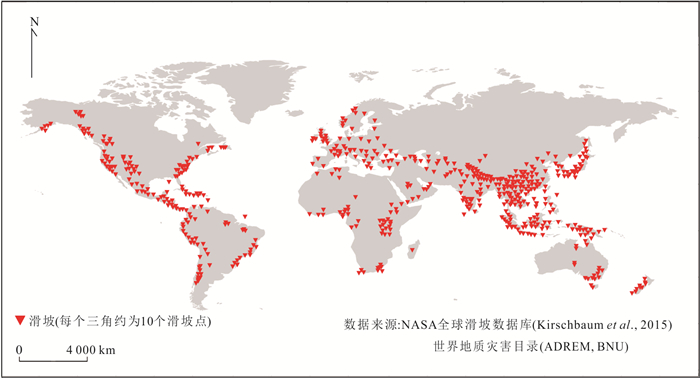
 下载:
下载:

